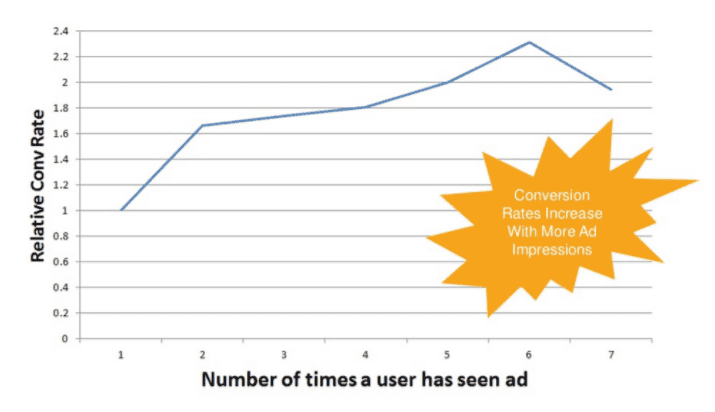Only 2% of people who visit your website will actually convert or make a purchase.
But what about the other 98%? What happens to them? After all, they visited your website, so they must be somewhat interested in your products and services or they wouldn’t be on your website, right?
Indeed, that is exactly correct. The problem is that they may also be comparison shopping at the same time or they got distracted and never made it back to your website. Perhaps their website crashed (ultimately, there are a lot of reasons why someone may leave your website).
This is the essence of why retargeting is so critical: it brings that lost 98% back to your website. It gives you another opportunity to build brand awareness and to guide interested prospects toward making the purchase.
In other words, it reminds those who got distracted of your business by keeping your business out in front; it sways the comparison shoppers with deals and discounts.
Before we can even go into more detail about why you should set up retargeting ads for your business, it’s important to understand what retargeting ads even are in the first place.
Retargeting is becoming more and more popular given that it is such a smart way to spend your ad dollars.
Retargeting (also sometimes referred to as remarketing) is a type of online targeting advertising that allows you to show banner ads to those who visited your website but left without doing what you wanted them to do – i.e. convert or make a purchase.
Without further ado, this blog post will take a look at why you should set up retargeting ads for your business.
1. Drive Repeat Visitors Back To Your Website
Here’s an important thing to understand about the buyer journey: it doesn’t necessarily happen in a linear path. Potential customers don’t visit your website, sign up for your newsletter and then make a purchase all in the same day.
Instead, the buyer journey happens in a very non-linear fashion. The problem is that while these visitors may be interested in what you’re selling, once they leave there is no guarantee that they will return again.
With retargeting ads, however, this changes. You can stay in front of prospects and lead them to make a purchase.
Again, only 2% of people convert the first time they visit your website; retargeting ads bring back the remaining 98%. If you don’t have a plan for the other 98% of window shoppers that visit your website, you’re losing out on a lot of business.
Many marketing professionals will say that people will make a purchase after 7 interactions with your business. The problem is that this strategy would take up a lot of time and effort to actually execute.
Retargeting is a much more effective strategy. You can simply show your ads to people as many times as you’d like while still creating that necessary point of contact.
Nearly 3 out of 5 online buyers notice retargeting ads.
In fact, you have likely experienced this first-hand yourself; have you ever looked at hotels or other products and then noticed ads for that same hotel or other product as you browsed around the Internet?
If your website gets at least 100 visitors every month, retargeting is a long-term strategy that is designed to get those prospects back to your website again so that they actually convert.
2. Increase Conversions & Sales
Retargeting allows you to stay in front of your leads until they are ready to make a purchase. And studies show that retargeting will do exactly that: it will increase both conversions and sales (more on this to come).
But first, here are a few real-life examples of how retargeting has worked for some businesses out there.
Take WordStream. Over a period of 18 months, their retargeting campaign increased their repeat visitors by 50%. On top of this, they increased their conversions by 51% and increased the amount of time that their visitors spent on their site by 300%!
Here’s another example of how remarketing has worked for other companies out there. The company behind Kleenex and Huggies, Kimberly-Clark, sees between 50% and 60% higher conversion rates with retargeting.
Neil Patel spends nearly ¼ of his entire advertising budget on just retargeting.
You may think that people might like seeing retargeting ads while they browse the Internet. When it comes to retargeting, however, it’s actually not true.
WordStream has found that conversion rates actually increase with more impressions.
Indeed, one study found that when visitors are retargeted, they are as much as 70% more likely to convert.

But, just why is retargeting so effective? There are actually a couple of reasons why retargeting is so effective. First, there’s the fact that you can customize your ads based on actions that visitors took on your site.
Here’s an example: let’s say that you run a massage therapy clinic and a visitor is looking at the acupuncture page of your website. They aren’t quite ready if they want to try acupuncture yet, so they leave your website.
Instead of leaving it up to chance that they return to your website, retargeting allows you to show them specific acupuncture ads with customized call-to-actions and offers, such as 10% off their first purchase.
You can continue to customize your offer until you finally lure them back to your site so that they complete the purchase.
Another reason why retargeting is so effective is because it doesn’t show ads to people who visited your site (this is one important component, but it’s not the whole story).
Ultimately, however, just because someone visited your site, it doesn’t necessarily mean that they align with your target market.
For example, they may not necessarily be able to afford your products/services and so on. Nevertheless, retargeting allows you to target those based on various demographic options like age, life events in addition to purchase history and other similar factors.
In other words, retargeting is effective because it shows ads to those who visited your website but also those in your target market as well for even more power.
Also keep in mind that you can target anonymous website visitors (this is the most common technique, called pixel-based retargeting) as well as contacts in your database (this is called list-based retargeting).
3. Build Your Brand
Businesses rely on retargeting to not only increase conversions/sales, but to also build their brand. And they are right. Retargeting works by showing visitors ads that bear the same logo and slogan again and again, which increases your visibility and promotes brand growth.
By making your brand much more memorable, you actually increase the customer lifetime value as a result as well.
Sure, search ads and organic search can be effective, but when it comes to building your brand, they simply cannot compete with retargeting ads.
The reason is simple: these type of ads lack the space needed to display your logo and other visual elements that are the essence of building a brand.
You have a lot more creativity with retargeting ads; this means that you have a lot of an opportunity to stand out from the rest as well.
4. It’s Cost-Effective
Retargeting costs much less than trying to actually generate traffic to your website in the first place.
The initial cost to acquire a click will be a few dollars, but once this has taken place, you can track that customer mere cents.
5. Maximize Your Ad Spending
Businesses don’t have an unlimited supply of money that they can devote to advertising – this is especially true for small businesses.
Remarketing allows you to maximize your ad spending by only showing your ads to visitors who are much more likely to convert given that they have already visited your website.
Indeed, many businesses make the mistake of spending money on attracting first-time visitors to their site, but the problem with this strategy is that these visitors may not be likely to convert. After all, they may not have any interest in your product at all.
It’s actually the equivalent of cold calling, which has been replaced with much smarter strategies like only reaching out to those who have expressed interest in your product or services. Retargeting essentially nudges those repeat visitors into taking action.
Further, and as mentioned above, retargeting also allows you to target those who are already part of your target market as well, giving you an additional bang for your buck. With typical display advertising, you are unable to control who, exactly, sees your ads.
In this case, there is definitely an element of luck involved that your ads are being shown to the right people. With retargeting, however, you have much more control over who sees your ads, which makes your campaign much more effective as a result.
6. Gain Important Insights
Just like any marketing campaign, retargeting comes with its own set of analytics that can be very beneficial for your business. In this case, the analytics will show you exactly where your visitors are being recaptured once they leave your site.
It is exactly these type of insights that are critical to making your retargeting campaigns even more powerful as time goes on.
Also, consider that retargeting is not just another marketing trend. It is not only here to stay but it also continues to evolve as the technology advances. Getting started with retargeting now means that you will be able to take advantage of those benefits as the technology progresses.
The Bottom Line
Given that 98% of visitors to your website are not ready to buy, retargeting is the smartest strategy out to connect with these interested prospects instead of spending your ad dollars on those who may not be interested in your products at all.
As a result, retargeting allows you to increase conversions and brand awareness all in a cost-effective manner. And the studies prove that retargeting does exactly this.
Now that you know why retargeting ads are so critical, you’re probably wondering how to actually set them up. We’ve actually already covered that topic on the blog, which you can read here.
*
Yocale is the premier destination for scheduling software today. It’s also free. You can try mental health software free. We also offer a range of various business-related tools – again, at absolutely no cost. Click here to sign up or learn more.
Want to stay up to date on everything digital marketing? If so, you’re at the right destination. We blog about it here every single day of the week.




